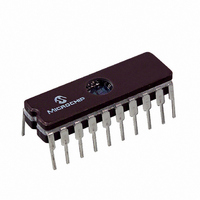PIC16C782/JW Microchip Technology, PIC16C782/JW Datasheet - Page 133

PIC16C782/JW
Manufacturer Part Number
PIC16C782/JW
Description
IC MCU EPROM 2KX14 COMP 20CDIP
Manufacturer
Microchip Technology
Series
PIC® 16Cr
Datasheets
1.PIC16C781-ISO.pdf
(186 pages)
2.PIC16C781-ISO.pdf
(8 pages)
3.PIC16C781-ISO.pdf
(8 pages)
Specifications of PIC16C782/JW
Core Processor
PIC
Core Size
8-Bit
Speed
20MHz
Peripherals
Brown-out Detect/Reset, POR, PWM, WDT
Number Of I /o
13
Program Memory Size
3.5KB (2K x 14)
Program Memory Type
EPROM, UV
Ram Size
128 x 8
Voltage - Supply (vcc/vdd)
4 V ~ 5.5 V
Data Converters
A/D 8x8b; D/A 1x8b
Oscillator Type
Internal
Operating Temperature
0°C ~ 70°C
Package / Case
20-CDIP (0.300", 7.62mm) Window
For Use With
DVA16XP202 - ADAPTER DEVICE PIC16C781/782DM163012 - BOARD DEMO PICDEM FOR 16C781/782AC164028 - MODULE SKT PROMATEII 20SOIC/DIP
Lead Free Status / RoHS Status
Contains lead / RoHS non-compliant
Eeprom Size
-
Connectivity
-
Other names
Q1137459
Available stocks
Company
Part Number
Manufacturer
Quantity
Price
14.12 Power-down Mode (SLEEP)
Power-down mode is entered by executing a SLEEP
instruction.
If enabled, the Watchdog Timer is cleared but keeps
running, the PD bit (STATUS<3>) is cleared, the TO
(STATUS<4>) bit is set, and the oscillator driver is
turned off. The I/O ports maintain the status they had,
before the SLEEP instruction was executed (driving
high, low, or hi-impedance).
For lowest current consumption in this mode:
• place all I/O pins at either V
• ensure no external circuitry is drawing current
• power-down all peripherals,
• disable external clocks.
Pull all I/O pins that are hi-impedance inputs, high or low
externally to avoid switching currents caused by floating
inputs. The T0CKI input should also be at V
lowest current consumption. The contribution from on-
chip pull-ups on PORTB should be considered.
14.12.1
The device can wake-up from SLEEP through one of
the following events:
1.
2.
3.
External MCLR Reset causes a device RESET. All other
events are considered a continuation of program execu-
tion and cause a "wake-up". The TO and PD bits in the
STATUS register can be used to determine the cause of
device RESET. The PD bit, which is set on power-up, is
cleared when SLEEP is invoked. The TO bit is cleared if
a WDT time-out occurred (and caused wake-up).
The following peripheral interrupts can wake the device
from SLEEP:
1.
2.
3.
4.
5.
from the I/O pin,
2001 Microchip Technology Inc.
External RESET input on MCLR pin.
Watchdog Timer Wake-up (if WDT was
enabled).
Interrupt from INT pin, PORTB IOCB, or any
Peripheral Interrupts.
TMR1 interrupt. Timer1 must be operating as an
asynchronous counter.
ADC conversion (when ADC clock source is RC).
Programmable low voltage detect.
Comparator C1 or C2 interrupt-on-change.
OPA in Comparator mode using IOCB.
WAKE-UP FROM SLEEP
DD
, or V
SS
,
DD
or V
SS
Preliminary
for
Other peripherals cannot generate interrupts since dur-
ing SLEEP, no on-chip clocks are present.
When the SLEEP instruction is being executed, the next
instruction (PC + 1) is pre-fetched. For the device to
wake-up through an interrupt event, the corresponding
interrupt enable bit must be set (enabled). Wake-up is
regardless of the state of the GIE bit. If the GIE bit is
clear (disabled), the device continues execution at the
instruction after the SLEEP instruction. If the GIE bit is
set (enabled), the device executes the instruction after
the SLEEP instruction, then branches to the interrupt
address (0004h). In cases where the execution of the
instruction following SLEEP is not desirable, the user
should have a NOP after the SLEEP instruction.
14.12.2
When global interrupts are disabled (GIE cleared) and
any interrupt source has both its interrupt enable bit
and interrupt flag bit set, one of the following will occur:
• If the interrupt occurs before the execution of a
• If the interrupt occurs during or after the execu-
Even if the flag bits were checked before executing a
SLEEP instruction, it may be possible for flag bits to
become set before the SLEEP instruction completes. To
determine whether a SLEEP instruction executed, test
the PD bit. If the PD bit is set, the SLEEP instruction
was executed as a NOP.
To ensure that the WDT is cleared, a CLRWDT instruc-
tion should be executed before a SLEEP instruction.
SLEEP instruction, the SLEEP instruction com-
pletes as a NOP. Therefore, the WDT and WDT
postscaler are not cleared, the TO bit is not set,
and PD bits are not cleared.
tion of a SLEEP instruction, the device immedi-
ately awakens from SLEEP. The SLEEP
instruction will be completely executed before the
wake-up. Therefore, the WDT and WDT
postscaler are cleared, the TO bit is set, and the
PD bit is cleared.
WAKE-UP USING INTERRUPTS
PIC16C781/782
DS41171A-page 131















